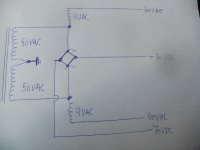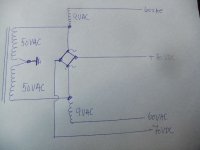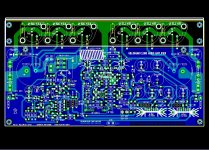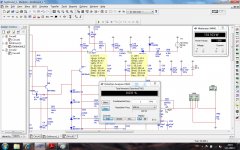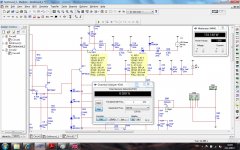OK
feel free to continue with this sharade ;
in any case - thank you for sharing schematic with anyone interested
but - rest of thread didn't help you in establishing any credentials , especially naming puzzle builders of Pass 20$ amps ;
majority of DiyA members are puzzle builders , but many of them are experts in other areas of professional life .
think about that - mixing with ppl in public forum is way more than pure tech. knowledge
feel free to continue with this sharade ;
in any case - thank you for sharing schematic with anyone interested
but - rest of thread didn't help you in establishing any credentials , especially naming puzzle builders of Pass 20$ amps ;
majority of DiyA members are puzzle builders , but many of them are experts in other areas of professional life .
think about that - mixing with ppl in public forum is way more than pure tech. knowledge
Looking at this schematic, or any other for that matter, the MOSFETS "OBVIOUSLY" need to be matched, at least they have to be matched close enough. My mistakeI'm still definitely against the source resistors. They're not needed. Just MATCH your MOSFETS! Most MOSFETS from a certain batch will probably already be close enough and no further matching will be required. In worst case scenario, source resistors can be installed as Bigpanda has suggested But that's a band aid and not a proper way of building an amplifier. Point of the story: MATCH your MOSFETS, or at least check them to see if they're already close enough.
Again, sorry to all those who I argued with before.
Wow talk about a complete change in tune....
Dougie085 - Yeah... I took a look at the datasheets for the original Hitachi 2SK134/2SJ49 MOSFETS and all of their equivalents. Their Vgs has a fairly big variance/spread, it's between 0.15V-1.50V. It shouldn't be that big of a problem, as most MOSFETS within a batch are usually matched close enough. But as an example, if someone gets a MOSFET with a Vgs = 0.2V and another with a Vgs = 1.3V, it could definitely pose a problem and some of the MOSFETS could overheat.
I wouldn't worry about this at all. Just check to make sure they're close enough
I wouldn't worry about this at all. Just check to make sure they're close enough
Transformer question
Thank you Nagys for your answer regarding the transformer I want to use. Your adwise is to unwind down to 2x40 VAC and run Goldmund as a 2x100 W amplifier.
Being a happy owner of a pair of Magnepan 1.6 loadspeakers, I want to “take” every watt that is possible from the Goldmund. I will “loose” a lot of watts "taking away" 2x10VAC from my transformer. Using 2x50VAC for the output stage will give an output some place between 2x100W (with 2x40VAC) and 2x250W (with 2x60VAC) I assume.
Before I listen to your adwise, bite into the sour apple and unwind down, I will ask you and other members about this solution taken from my LFA 50 from the nineties (photo)
I have a second reason to seek for other solution than to unwind my 2x50vAC transformer and go for my "own"(photo)
Nagys said:
“The input stage will be fed by taking the 40VAC before the bridge and the +/- rails will be fed with the voltage taken after the bridge, 40 X 1.414 = +/- 57VDC. Close enough to +/- 60VDC”.
This I do not understand because:
According to 9.2 Schematic the input stage should be fed with 60VAC not +/- 60VDC. What have I misunderstood (if I have)?
Eivind Stillingen
Thank you Nagys for your answer regarding the transformer I want to use. Your adwise is to unwind down to 2x40 VAC and run Goldmund as a 2x100 W amplifier.
Being a happy owner of a pair of Magnepan 1.6 loadspeakers, I want to “take” every watt that is possible from the Goldmund. I will “loose” a lot of watts "taking away" 2x10VAC from my transformer. Using 2x50VAC for the output stage will give an output some place between 2x100W (with 2x40VAC) and 2x250W (with 2x60VAC) I assume.
Before I listen to your adwise, bite into the sour apple and unwind down, I will ask you and other members about this solution taken from my LFA 50 from the nineties (photo)
I have a second reason to seek for other solution than to unwind my 2x50vAC transformer and go for my "own"(photo)
Nagys said:
“The input stage will be fed by taking the 40VAC before the bridge and the +/- rails will be fed with the voltage taken after the bridge, 40 X 1.414 = +/- 57VDC. Close enough to +/- 60VDC”.
This I do not understand because:
According to 9.2 Schematic the input stage should be fed with 60VAC not +/- 60VDC. What have I misunderstood (if I have)?
Eivind Stillingen
Attachments
Last edited:
Dougie085 - Yeah... I took a look at the datasheets for the original Hitachi 2SK134/2SJ49 MOSFETS and all of their equivalents. Their Vgs has a fairly big variance/spread, it's between 0.15V-1.50V. It shouldn't be that big of a problem, as most MOSFETS within a batch are usually matched close enough. But as an example, if someone gets a MOSFET with a Vgs = 0.2V and another with a Vgs = 1.3V, it could definitely pose a problem and some of the MOSFETS could overheat.
I wouldn't worry about this at all. Just check to make sure they're close enough
If you read this article you can also learn how to select a proper transformer
for the 9.2 amp: Amplifier Efficiency (Amplifier Efficiency)
Not all energy/power goes out to the speakers, only between 40 - 60 %, that is why an amplifier needs heatsinks!!!
PCB ....rev ,rev,rev,rev many times
.......for those ,who wish to be added resistors on bottom for sources will do like in picture so screws and insulators are differences in how they will be installed , I think . Liliya , an simple schematic how must be connected ..
Liliya , an simple schematic how must be connected ..
Alex.
.......for those ,who wish to be added resistors on bottom for sources will do like in picture so screws and insulators are differences in how they will be installed , I think .
Alex.
Attachments
Looking at this schematic, or any other for that matter, the MOSFETS "OBVIOUSLY" need to be matched, at least they have to be matched close enough. My mistakeI'm still definitely against the source resistors. They're not needed. Just MATCH your MOSFETS! Most MOSFETS from a certain batch will probably already be close enough and no further matching will be required. In worst case scenario, source resistors can be installed as Bigpanda has suggested But that's a band aid and not a proper way of building an amplifier. Point of the story: MATCH your MOSFETS, or at least check them to see if they're already close enough.
Again, sorry to all those who I argued with before.
Finally some sense and a bit of humility. This is what countless people have been trying to tell you.
Ideally no source resistor is best, but people may not be able to afford to buy a big batch of mosfets for matching so the resistor may become mandatory for those people who do not have the funds or the ability to match mosfets.
Hi Liliya,
As I already say If lowering the DC supply at output stage will not lower the power of the amplifier. If you have 2x50VAC transformer don't worry the solution is very simple: change the drop resistors R32 and R33 with value between 1.9k-2.0k (3W is fine) and input tage will go to around 80VDC. I am not recommend to remove a pair of MOSFET's. By the way the current through T21 and T22 is around 26mA and there are not needed any heatsink.
Best regards
As I already say If lowering the DC supply at output stage will not lower the power of the amplifier. If you have 2x50VAC transformer don't worry the solution is very simple: change the drop resistors R32 and R33 with value between 1.9k-2.0k (3W is fine) and input tage will go to around 80VDC. I am not recommend to remove a pair of MOSFET's. By the way the current through T21 and T22 is around 26mA and there are not needed any heatsink.
Best regards
Transformer and source resistors.
Ivodonchev, thank you.
Dropping 32/33 down to a lower value: A straightforward solution for me (and others).
But we are still talking of 50VAC to this point and not DC?
Alex, thanks to you too for listening about the source resistor. Your proposal to this on the underside of PCB will be easy to adapt for those who want/need it.
Eivind Stillingen
Ivodonchev, thank you.
Dropping 32/33 down to a lower value: A straightforward solution for me (and others).
But we are still talking of 50VAC to this point and not DC?
Alex, thanks to you too for listening about the source resistor. Your proposal to this on the underside of PCB will be easy to adapt for those who want/need it.
Eivind Stillingen
- Home
- Amplifiers
- Solid State
- The Very Best Amplifier I Have Ever Heard!!!!
